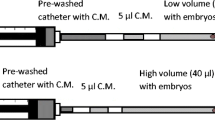Purpose: The aim of this prospective, randomized trial was to evaluate the efficacy of Embryo-Glue® as a human embryo transfer medium in IVF/ICSI cycles.
Method: A total of 815 nonselected patients undergoing IVF/ICSI treatment between September 2003 and February 2004 were randomly allocated into the test (417 patients) and the control (398 patients) groups. In both groups, embryos were cultured in G-1™ver 3, supplemented with 10% recombinant human albumin. On the day of embryo transfer (day 3), the best or good quality embryos were selected for intrauterine transfer. In the test group, the selected embryos were treated with EmbryoGlue® prior to the transfer, whereas in the control group they were transferred without any treatment.
Results: The patients’ characteristics such as age and the number of ART cycles and also the number of patients in each indication of infertility and the number of embryos selected for transfer were all similar between the two groups. In the test group, the clinical pregnancy rate in the tubal factors and the implantation rate in the tubal factors and recurrent implantation failures increased significantly compared with those in the control group. In the test group, life birth and the triplet delivery rates increased significantly compared with those in the control group.
Conclusion: EmbryoGlue® is a useful embryo transfer medium, and at least in some infertile patients it can improve clinical implantation and ongoing pregnancy rates.
Similar content being viewed by others
REFRENCES
Simon A, Safran A, Revel A, Aizenman E, Reubinoff B, Porat-Katz A, Lewin A, Laufer N: Hyaluronic acid can successfully replace albumin as the sole macromolecule in a human embryo transfer medium. Fertil Steril 2003;79:1434–1438
Leese HJ: Formation and function of oviduct fluid. J Reprod Fertil 1988:82:843–856
Gardner DK, Rodriegez-Martinez H, Lane M: Fetal development after transfer is increased by replacing protein with the glycosaminoglycan hyaluronan for mouse embryo culture and transfer. Hum Reprod 1999:14:2575–2580
Stojkovic M, Thompson JC, Tervit HR: Effects of hyaluronic acid supplementation on in vitro development of bovine embryos in a two step culture system. Theriogenol Abstr 1999;51:254
Stojkovic M, Kolle S, Peinl S, Stojkovic P, Zakhartchenko V, Thompson JG, Wenigerkind H, Reichenbach HD, Sinowatz F, Wolf E: Effects of high concentrations of hyaluronan in culture medium on development and survival rates of fresh and frozen-thawed bovine embryos produced in vitro. Reproduction 2002;124:141–153
Eppig JJ: FSH stimulates hyaluronic acid synthesis by oocyte-cumulus cell complexes from mouse preovulatory follicles. Nature 1979;281:483–484
Grimek HJ, Bellin ME, AX RL: Characteristics of proteoglycans isolated from small and large bovine ovarian follicles. Biol Reprod 1984;30:397–409
Binette JP, Ohishi H, Burgi W, Kimura A, Suyemitsu T, Seno N, Schmid K: The content and distribution of glycosaminoglycans in the ejaculates of normal and vasectomized men. Andrologia 1996;28:145–149
Carson DD, Dutt A, Tang JP: Glycoconjugate synthesis during early pregnancy: Hyaluronate synthesis and function. Dev Biol 1987;120:228–235
Gardner DK, Lane M: Recombinant human serum albumin and hyaluronan can replace blood-derived albumin in embryo culture media. Fertil Steril Suppl 2000;74:31–32
Schoolcraft W, Lane M, Stevens J, Gardner DK: Increased hyaluronan concentration in the embryo transfer medium results in a significant increase in human embryo implantation rate. Fertil Steril 2002;76(Suppl 3):S5
Gardner DK, Lane MW, Lane M: EDTA stimulates cleavage stage bovine embryo development in culture but inhibits blastocyst development and differentiation. Mol Reprod Dev 2000;57:56–261
Lane M, Gardner DK: Non-essential amino acids and glutamine decrease the time if the first cleavage divisions and increase compaction of mouse zygotes in vitro. J Assist Reprod Genet 1997;14:398–403
Lane M, Gardner DK: Effect of essential amino acids on mouse embryo viability and ammonium production. J Assist Reprod Genet 2001;18:519–525
Porter RN, Smith W, Craft IL, Abdulwahid NA, Jacobs HS: Induction of ovulation for in- vitro fertilisation using buserelin and gonadotropins. Lancet 1984;324:1284–1285
Balaban B, Isiklar A, Yakin K, Gursoy H, Urman B: Increased implantation rates in patients with recurrent implantation failures following the use a new transfer medium enriched with hyaluronan. Hum Reprod Suppl 2004;19:7
Turley E, Moore DC: Hyaluronate binding proteins also bind to fibronectin, laminin and collagen. Biochem Biophys Res Commun 1984;121:808–814
Scott JE: Supramolecular organization of extracellular matrix glycosaminoglycans, in vitro and in the tissues. FASEB J 1992;6:2639–2645
Fraser JRE, Laurent TC, Laurent UBG: Hyaluronan: Its nature, distribution, function and turnover. J Intern Med 1997;242:27–33
West DC, Hampson IN, Arnold F, Kumar S: Angiogenesis induced by degradation products of hyaluronic acid. Science 1985;228:1324–1326
Sato E, Tanaka T, Takeya T, Miyamoto H, Koide SS: Ovarian glycosaminoglycans potentiate angiogenic activity of epidermal growth factor in mice. Endocrinology 1991;128:2402–2406
Paria BC, Das SK, Gupta A, Dey SK: Reversal of indomethacin-induced inhibition of implantation in the mouse by epidermal growth factor. Prostaglandins 1991;42:191–199
Laurent TC, Fraser JRE: Hyaluronan. FASEB J 1992;6:2397–2404
ACKNOWLEDGMENTS
We are grateful to Dr Reza Samani, Mrs Mansoureh Forghani, and Mrs Akram Teimouri for their assistance with this paper. Special thanks to Prof Hamberger who has carefully reviewed the manuscript.
Author information
Authors and Affiliations
Corresponding author
Rights and permissions
About this article
Cite this article
Valojerdi, M.R., Karimian, L., Yazdi, P.E. et al. Efficacy of a human embryo transfer medium: a prospective, randomized clinical trial study. J Assist Reprod Genet 23, 207–212 (2006). https://doi.org/10.1007/s10815-006-9031-7
Received:
Accepted:
Published:
Issue Date:
DOI: https://doi.org/10.1007/s10815-006-9031-7



